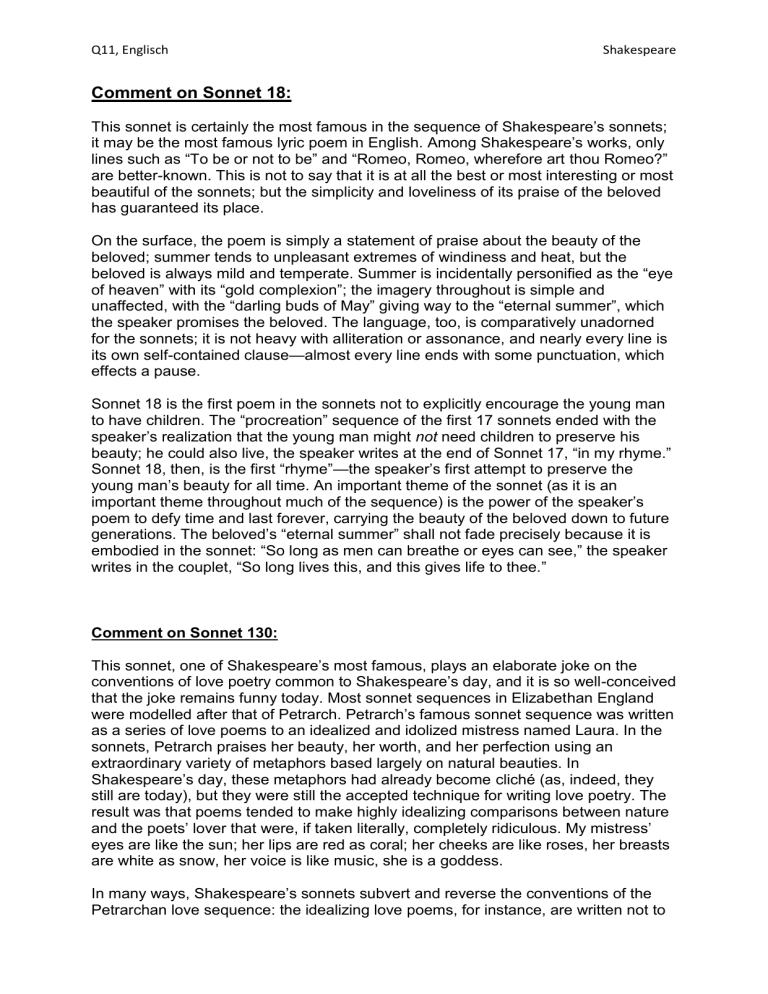
Q11, Englisch Shakespeare Comment on Sonnet 18: This sonnet is certainly the most famous in the sequence of Shakespeare’s sonnets; it may be the most famous lyric poem in English. Among Shakespeare’s works, only lines such as “To be or not to be” and “Romeo, Romeo, wherefore art thou Romeo?” are better-known. This is not to say that it is at all the best or most interesting or most beautiful of the sonnets; but the simplicity and loveliness of its praise of the beloved has guaranteed its place. On the surface, the poem is simply a statement of praise about the beauty of the beloved; summer tends to unpleasant extremes of windiness and heat, but the beloved is always mild and temperate. Summer is incidentally personified as the “eye of heaven” with its “gold complexion”; the imagery throughout is simple and unaffected, with the “darling buds of May” giving way to the “eternal summer”, which the speaker promises the beloved. The language, too, is comparatively unadorned for the sonnets; it is not heavy with alliteration or assonance, and nearly every line is its own self-contained clause—almost every line ends with some punctuation, which effects a pause. Sonnet 18 is the first poem in the sonnets not to explicitly encourage the young man to have children. The “procreation” sequence of the first 17 sonnets ended with the speaker’s realization that the young man might not need children to preserve his beauty; he could also live, the speaker writes at the end of Sonnet 17, “in my rhyme.” Sonnet 18, then, is the first “rhyme”—the speaker’s first attempt to preserve the young man’s beauty for all time. An important theme of the sonnet (as it is an important theme throughout much of the sequence) is the power of the speaker’s poem to defy time and last forever, carrying the beauty of the beloved down to future generations. The beloved’s “eternal summer” shall not fade precisely because it is embodied in the sonnet: “So long as men can breathe or eyes can see,” the speaker writes in the couplet, “So long lives this, and this gives life to thee.” Comment on Sonnet 130: This sonnet, one of Shakespeare’s most famous, plays an elaborate joke on the conventions of love poetry common to Shakespeare’s day, and it is so well-conceived that the joke remains funny today. Most sonnet sequences in Elizabethan England were modelled after that of Petrarch. Petrarch’s famous sonnet sequence was written as a series of love poems to an idealized and idolized mistress named Laura. In the sonnets, Petrarch praises her beauty, her worth, and her perfection using an extraordinary variety of metaphors based largely on natural beauties. In Shakespeare’s day, these metaphors had already become cliché (as, indeed, they still are today), but they were still the accepted technique for writing love poetry. The result was that poems tended to make highly idealizing comparisons between nature and the poets’ lover that were, if taken literally, completely ridiculous. My mistress’ eyes are like the sun; her lips are red as coral; her cheeks are like roses, her breasts are white as snow, her voice is like music, she is a goddess. In many ways, Shakespeare’s sonnets subvert and reverse the conventions of the Petrarchan love sequence: the idealizing love poems, for instance, are written not to Q11, Englisch Shakespeare a perfect woman but to an admittedly imperfect man, and the love poems to the dark lady are anything but idealizing (“My love is as a fever, longing still / For that which longer nurseth the disease” is hardly a Petrarchan conceit.) Sonnet 130 mocks the typical Petrarchan metaphors by presenting a speaker who seems to take them at face value, and somewhat bemusedly, decides to tell the truth. Your mistress’ eyes are like the sun? That’s strange—my mistress’ eyes aren’t at all like the sun. Your mistress’ breath smells like perfume? My mistress’ breath reeks compared to perfume. In the couplet, then, the speaker shows his full intent, which is to insist that love does not need these conceits in order to be real; and women do not need to look like flowers or the sun in order to be beautiful. The rhetorical structure of Sonnet 130 is important to its effect. In the first quatrain, the speaker spends one line on each comparison between his mistress and something else (the sun, coral, snow, and wires—the one positive thing in the whole poem some part of his mistress is like. In the second and third quatrains, he expands the descriptions to occupy two lines each, so that roses/cheeks, perfume/breath, music/voice, and goddess/mistress each receive a pair of unrhymed lines. This creates the effect of an expanding and developing argument, and neatly prevents the poem—which does, after all, rely on a single kind of joke for its first twelve lines— from becoming stagnant.





